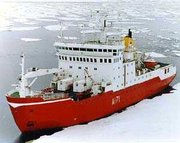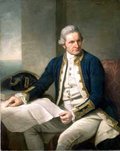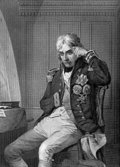Royal Navy
|
|
Template:Royal Navy The Royal Navy of the United Kingdom is the "senior service" of the armed services, being the oldest of its three branches. From approximately 1692 until World War II, the Royal Navy was the largest and most powerful navy in the world. The navy helped establish the United Kingdom as the dominant military power of the 19th century, and was essential for maintaining the British Empire. Although the Royal Navy is now much smaller, it remains the largest European navy, and one of the world's most technologically advanced.
| Contents |
History
- Main article: History of the Royal Navy
The Royal Navy has historically played a central role in the defence and warfare of England, and later Great Britain, the United Kingdom, and the British Empire. Because Great Britain and Ireland are islands and no point in the UK is more than 74 miles (120 km) from the sea, any enemy power (at least, before aircraft) would have had to cross the sea in order to attack the island. Attainment of naval superiority by any hostile power would have placed the nation in great peril. Moreover, a strong navy was vital in maintaining the security of supply and communication links with distant locations in the Empire.
England (c800 to c1700)
England's first navy was established in the 9th century by Alfred the Great, but soon fell into disrepair. The Norman kings started an equivalent in 1155 with the creation of the Cinque Ports alliance and the establishment of the post of Lord Warden of the Cinque Ports. This was effective during the Plantagenet years, but like most institutions of the type fell into disarray and disuse.
The first reformation and major expansion of the Navy Royal, as it was then known, occurred in the 16th Century during the reign of Henry VIII whose ships, Henri Grâce a Dieu ("Great Harry") and Mary Rose, engaged the French navy in the battle of the Solent in 1545. By the time of Henry's death in 1547 his fleet had grown to 58 vessels.
In 1588 the Spanish Empire, at the time the world's great superpower, threatened England with invasion and the Spanish Armada set sail to enforce Spain's dominance over the English Channel and transport troops from the Spanish Netherlands to England. However, the armada failed, due to a combination of repeated successful attacks by the much smaller Royal Navy of England, bad weather and a revolt by the Dutch in Spain's territories across the Channel. The defeat of the armada is the first major victory by the English at sea. England continued to raid Spain's ports and ships travelling across the Atlantic Ocean under the reign of Elizabeth I.
1692-1914
A permanent Naval Service didn't really exist until the mid-17th century when the Fleet Royal was taken under Parliamentary control following the defeat of Charles I in the English Civil War. This second reformation of the navy was carried out under Robert Blake during Oliver Cromwell's Commonwealth. The incorporation of the Royal Navy was in contrast to the land forces, which are descended from variety of different sources including both royal and anti-royal Parliamentary forces.
Between 1692 and 1940 the Royal Navy was the strongest navy in the world with almost uncontested power over the world's oceans. In that time, the Royal Navy suffered only one major defeat - the battle of the Chesapeake against France in 1781 - and was able to defeat all challengers, as at the Battle of Trafalgar in 1805 where a combined Spanish and French fleet was decisively beaten (despite the British fleet being outnumbered).
In the 19th century, the Royal Navy was crucial in allowing Britain to maintain the British Empire. In addition, the Royal Navy was involved in enforcing the ban on the slave trade and the suppression of piracy.
Life in the early Royal Navy would be considered harsh by today's standards; discipline was severe and flogging was used to enforce obedience to the Articles of War. The law allowed the Navy to use the unpopular practice of impressment where seamen were forced to serve in the Navy during times of manpower shortage, usually in wartime. Impressment reached its peak in the 18th and early 19th century but was abandoned after the end of the Napoleonic Wars as the peacetime Navy was smaller.
1914-1945
During the two World Wars, the Royal Navy played a vital role in keeping the UK supplied with food, arms, and raw materials, and in defeating the German campaigns of unrestricted submarine warfare in the first and second battles of the Atlantic. It was also vital in guarding the sea lanes that enabled UK forces to fight in remote parts of the world such as North Africa, the Mediterranean, and the Far East. Naval supremacy was vital to the amphibious operations carried out, such as the invasions of Northwest Africa, Sicily, Italy, and Normandy. See British military history of World War II.
HMS_Warspite_(Valiant-class_submarine).jpg
Cold War
After World War II, the growing power of the United States and the decline of the British Empire, reduced the role of the Royal Navy. However the threat of the Soviet Union and continuing British commitments throughout the world created a new and important role for the Navy. In the 1960s, the Royal Navy received its first nuclear weapons and was later to become the sole carrier of the UK's nuclear deterrent. In the latter stages of the Cold War, the Royal Navy was reconfigured with three anti-submarine warfare aircraft carriers and a force of small frigates and destroyers. Its purpose was to search for and, if necessary, destroy Soviet submarines in the North Atlantic.
Recent Operations
The most important post-war operation conducted solely by the Royal Navy was the defeat in 1982 of Argentina in the Falkland Islands War. Despite losing 4 ships in the war, the Royal Navy proved it was still able to fight a battle 8,000 miles (12,800 km) from the British mainland. The war also focused the need of aircraft carriers and submarines.
The Royal Navy also participated in the Gulf War, the Kosovo conflict, the Afghanistan Campaign, and the 2003 Iraq War, the last of which saw RN warships bombard positions in support of the Al Faw Peninsula landings by Royal Marines. Also during that war, HM submarines Splendid and Turbulent launched a number of Tomahawk cruise missiles on a variety of targets in Iraq.
The Royal Navy today

Current Royal Navy deployments are vast, and encompass much of the world's oceans.
Atlantic Patrol Task (North)
In the Atlantic, the RN presence is considerable. Atlantic Patrol Task (North) is normally carried out by an escort vessel which patrols the Caribbean and North Atlantic areas.
Atlantic Patrol Task (South)
Atlantic Patrol Task (South) constitutes the RN's commitment to the South Atlantic and West African areas which is comprised of an escort vessel accompanied by an RFA vessel. Additionally, a vessel is permanently deployed as the Falkland Islands Guardship. This invariably tends to be a Castle-class patrol vessel. Also, Endurance is deployed for half the year as an Ice Patrol Ship.
U.K. waters
In UK waters, the RN's presence isn't as considerable, but the protection of fishery areas and offshore gas and oil installations is provided by the Fishery Protection Squadron. This is comprised of the new River-class patrol vessels, with a varying number of Hunt class minesweepers that rotate fishery protection duties with their mine counter measures work. The Northern Ireland Squadron exists to deter the movement of material to Northern Ireland which could be used to support terrorist activities there. Additionally a Fleet Ready Escort (FRE), made up of a single warship to provide a rapid response at short notice for a variety of tasks required of the ship.
Gulf
The RN also maintains a significant presence in the Persian Gulf. Currently, a single escort vessel is on patrol as part of Operation Oracle, another aspect of the UK's contribution to the War on Terror. Prior to this, the main RN contribution to the UK's presence in the region was provided by the Armilla Patrol which continues, and is made up of a single escort vessel and a supporting RFA vessel.
Far East
Though a permanent RN presence in the Far East and Pacific regions has ended, the RN deploys a significant Naval Task Group (NTG) approximately every three years as part of the Five Powers Defence Arrangements (FPDA) which was signed by the governments of Australia, Malaysia, New Zealand, Singapore, and the UK. NTG 03 had been intended to take part in FPDA exercises in the Asia-Pacific region but was diverted for involvement in the 2003 Iraqi War. A number of ships eventually undertook the deployment for the FPDA exercises.
NATO Standing Naval Force Mediterranean
The RN also has a substantial commitment to NATO. The UK normally provides a single escort to Standing Naval Force Atlantic (STANAVFORLANT) and Standing Naval Force Mediterranean (STANAVFORMED), both permanent NATO multi-national squadrons for those regions. The RN also usually provides a Mine Countermeasures vessel to Mine Countermeasures Force (North) and Mine Countermeasures Force (South), both important permanent NATO squadrons.
Nicknames for the Royal Navy include "The Mob", "The Andrew", and "The Senior Service", while nicknames for British sailors include "Limeys" and "Jacktars" (as in "every man-jack of 'em"). One point of pride of the Royal Navy is that it is known simply as "the Royal Navy", as most other navies include their national name.
The Napoleonic campaigns of the navy have been the subject of many novels including Patrick O'Brian's Jack Aubrey, C.S. Forester's Horatio Hornblower, and Alexander Kent's Richard Bolitho.
Ships of the Royal Navy
see List of ships of the Royal Navy
Commissioned (surface) ships of the Royal Navy are accorded the prefix HMS which stands for Her Majesty's Ship (alternatively, His Majesty's Ship), like HMS Ark Royal. Submarines on the other hand are styled HM Submarine, though still abbreviated HMS. Fleet support units, usually manned by civilians are given the prefix RFA or Royal Fleet Auxiliary, such as RFA Sir Galahad.
Commanders of the Royal Navy
The Commander-in-Chief of the Royal Navy, known as the Lord High Admiral, is the Queen (who is overall Commander-in-Chief of the UK Armed Forces). The office of Lord High Admiral was put into commission and was effectively replaced by the head of that commission, the First Lord of the Admiralty (the first one being in 1709), until this position was subsumed into that of Secretary of State for Defence in 1964. Since then, the historical title of Lord High Admiral has been restored and is vested to the Sovereign.
The professional head of the Royal Navy is the Chief of the Naval Staff (who also holds the title of First Sea Lord). The current incumbent is Admiral Sir Alan West.
Commander-in-Chief Fleet
Since 1971 there has been only one operational fleet level command in the Royal Navy. During that year with the withdrawal from Singapore the Eastern and Western fleets of the Royal Navy were unified into one command. It was initially based at Northwood in Middlesex, continuing the tradition of basing the home naval command there that had started in 1960 when the Home Fleet command had been transferred ashore. The head of this command is known as Commander-in-Chief Fleet, commonly abbreviated to CINCFLEET.
Recently most of CINCFLEET's staff has transferred to a new facility in Plymouth. However, CINCFLEET himself and a small staff remain at Northwood.
Royal Navy timeline and battle honours
| Missing image Turner,_The_Battle_of_Trafalgar_(1806).jpg The Battle of Trafalgar |
- 1588 The Spanish Armada
- 1652 Battle of Dungeness
- 1690 Battle of Beachy Head
- 1692 Battle of La Hougue
- 1759 Battle of Quiberon Bay
- 1780 Battle of Cape St. Vincent (1780)
- 1781 Battle of the Chesapeake
- 1782 Battle of the Saintes
- 1794 The Glorious First of June
- 1797 Battle of Cape St. Vincent (1797)
- 1798 Battle of the Nile
- 1801 Battle of Copenhagen
- 1805 Battle of Trafalgar
- 1821 First steam paddle ships for auxiliary use (tugs etc.)
- 1840 First screw driven Steamship, Rattler
- 1902 First Royal Navy submarine, Holland 1
- 1905 First Steam turbine and all big-gun battleship, Dreadnought
- 1914–1918 First Battle of the Atlantic
- 1914 Battle of Heligoland Bight, Battle of Coronel, Battle of the Falkland Islands
- 1915 Battle of Dogger Bank and Dardanelles Campaign
- 1916 Battle of Jutland
- 1919 Russian Civil War
- 1931 Invergordon Mutiny
- 1939–1945 Second Battle of the Atlantic
- 1939 Battle of the River Plate
- 1940 Operation Dynamo (Dunkirk)
- 1941 Battle of Cape Matapan
- 1941 Sinking of HMS Hood and the German battleship Bismarck
- 1942 Battle of North Cape
- 1944 Operation Tungsten
- 1944 Allied invasion of Normandy
- 1946 Mining of Saumarez and Volage in the Corfu Channel Incident
- 1949 Amethyst incident on the Yangtze River
- 1950 Korean War begins
- 1956 Suez campaign
- 1962 Indonesian Konfrontasi begins in Borneo
- 1963 First British nuclear submarine, Dreadnought
- 1965 Beira Patrol against Rhodesia begins
- 1980 Armilla Patrol in the Persian Gulf begins
- 1982 Falklands War
- 1991 Gulf War
- 1999 Kosovo conflict
- 2000 Sierra Leone
- 2001 Afghanistan Campaign
- 2003 Iraq War
Famous sailors of the Royal Navy
Famous ships of the Royal Navy
For a full list, see List of Royal Navy ship names
- Mary Rose — sank in 1545 off Portsmouth
- Ark Royal — flagship of English Fleet against the Spanish Armada. As of 2005, the current Ark Royal is an Invincible-class aircraft carrier that saw action in the 2003 Iraq conflict
- Bounty — scene of the famous mutiny.
- Victory — Nelson's flagship. This ship is still officially in service and is the world's oldest commissioned warship.
- Beagle — carried Charles Darwin on his voyage.
- Warrior — first ironclad warship
- Dreadnought — first "all big-gun" battleship
- Warspite — fought at Jutland and through the Second World War
- Hood — battlecruiser destroyed by the Bismarck
- Vanguard — last battleship built for the Royal Navy
- Dreadnought — first British nuclear-powered submarine
- Resolution — first British strategic ballistic missile submarine
- Invincible — light aircraft carrier currently in service
- Conqueror — nuclear attack submarine, responsible for the sinking of the ARA General Belgrano during the Falklands War.
See also
- The Admiralty
- Comparative military ranks
- Admiral
- Heart of oak -- A Royal Navy song
- Navy List
- Pink gin
- List of fleets (includes British fleets of the two World Wars)
- List of senior officers of the Royal Navy
- List of ships of the Royal Navy
- British Naval ensigns
- Department of Naval Intelligence
- British military history
- Royal Naval Division
- Standing Royal Navy Deployments
- The Royal Navy in the 21st Century
- UK topics
- The Royal British Legion
Further reading
- Arthur Herman, To Rule The Waves: How The British Navy Changed The World, Harpercollins (October, 2004), hardcover, 528 pages, ISBN 0060534249
External links
- Official Website of the Royal Navy (http://www.royal-navy.mod.uk/)
- Navy News - Royal Navy Newspaper (http://www.navynews.co.uk/)
Template:British Militaryde:Royal Navy fr:Royal Navy id:Angkatan Laut Inggris nl:Royal Navy ja:イギリス海軍 nb:Royal Navy nn:Royal Navy pl:Royal Navy



